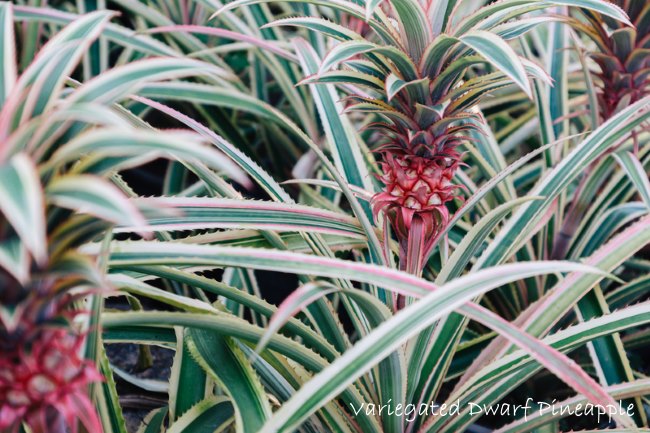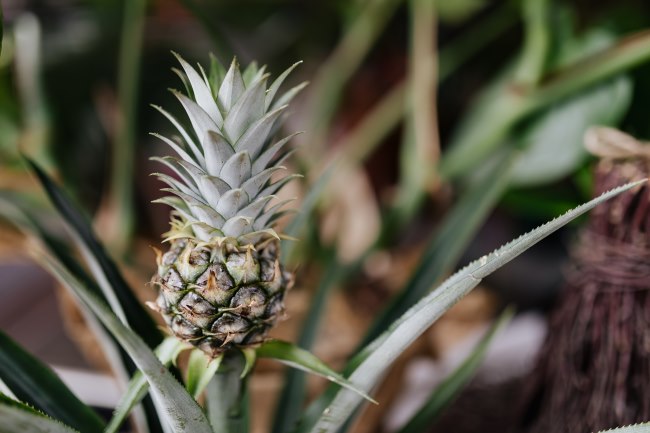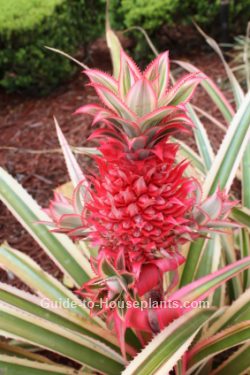Growing Pineapple Plants Indoors
Botanical Name: Ananas comosus
Want an unusual tropical plant? Growing pineapple plants indoors is easier than you may think -- and sure to grab attention.
The 'Variegatus' cultivar (shown below) is a variegated pineapple. It's much more attractive than the common pineapple. But don't expect to eat it. It's grown for decoration, not for its fruit which is bitter.
Dramatic sword-like leaves form a rosette and grow up to 3 ft (90 cm) long, so give your plant plenty of room. The green leaves are banded with creamy yellow and sometimes red. They're also studded with spines. Handle carefully -- those spines are sharp!
 Variegated dwarf pineapple makes an eye-catching houseplant. Photo © Svyatoslav Balan
Variegated dwarf pineapple makes an eye-catching houseplant. Photo © Svyatoslav BalanGet to Know Pineapple Plants
Pineapples are in the Bromeliad family, a group of more than 2,000 species. What most Bromeliads have in common is a rosette of leaves at the top that collects rainwater in their native habitat.
Ananas comosus is the common pineapple grown commercially for its fruit. A. comosus 'Variegatus' (shown above) is an ornamental variety and makes a better-looking house plant. It's known as variegated pineapple. Want a smaller plant? Look for the dwarf species Ananas nanus -- it reaches just 16 in (40 cm) tall.
Growing pineapple plants is easy. Getting them to flower and produce fruit is more of a challenge, but well worth the effort.
How to Make Pineapple Plants Bloom
You can encourage pineapple plants to flower and fruit with this easy trick:
Place a ripening apple or a few apple cores around the pineapple plant and cover the whole thing with a clear plastic bag for a couple weeks. The apple gives off ethylene gas that induces blooming.
Keep your plant out of direct sun while it's covered to prevent it from getting too hot.
How to Plant a Pineapple Top
Starting a pineapple plant from store-bought fruit is as simple as cutting off the top of the fruit and potting it.
Cut about 1 in (2.5 cm) of the fruit along with the tuft of leaves. Allow it to dry for a day. Then remove the lower leaves so that they're not sitting in soil and plant it in a small pot.
Keep it out of direct sunlight until you see new leaves growing, then gradually move it to a brighter location.
Care of pineapple plants requires lots of sunlight...and patience. It takes about 5 years or so before you'll see a fruit spike, then several more months for the fruit to form.
 Growing pineapple as a houseplant. Photo credit: Karolina Grabowska
Growing pineapple as a houseplant. Photo credit: Karolina GrabowskaGrowing Pineapple Plants Year-Round
Shed some light. Growing pineapple plants require plenty of light. It's a good idea to put your pineapple plant outdoors for the summer to give it the light it needs. Move it gradually to direct sun so that the foliage doesn't get scorched. This is a frost-tender plant. In fact, it doesn't do well in cold temperatures, so be sure to bring it back indoors when the temperature drops below 65°F/18°C in fall.
Repot in spring. Move to a pot 1 size larger only when necessary. Planting pineapple in a smallish container will help to control its size. Don't press the potting medium down -- like all bromeliads, growing pineapple plants like a little air around their roots. Use a heavy container to help balance the plant because it will get top-heavy as it grows.
Something bugging your houseplant? Pineapples seem to shrug off pests, but keep an eye out for scale insects. Treat any infestation immediately.
 Red pineapple (var. Tricolor)
Red pineapple (var. Tricolor)Indoor Pineapple Plant Care Tips
Origin: Brazil
Height: 3 ft (90 cm)
Light: Bright light to full sun
Water: Water thoroughly, allowing the top of the soil to dry out between waterings.
Humidity: Moderate to high room humidity. If the relative humidity drops below 45%, place the pot on a tray of wet pebbles to increase humidity around it. Or use a cool-mist room humidifier. Brown leaf tips are often caused by dry air.
Temperature: Warm year-round 65-85°F/18-29°C. Don't expose this tropical native to cool temps; keep your houseplant away from cold blasts near entryways or AC vents.
Soil: Fine-grade fir bark. Commercial bromeliad mix works best to allow fast drainage.
Fertilizer: Feed every 2 weeks spring through fall with a balanced water-soluble fertilizer diluted by half. In winter, feed monthly.
Propagation: Cut off the top of the fruit, allow it to dry for a day then pot it in a half-half mixture of moist fir bark and perlite or sand. Older plants may produce offsets which can be cut away and potted separately.


